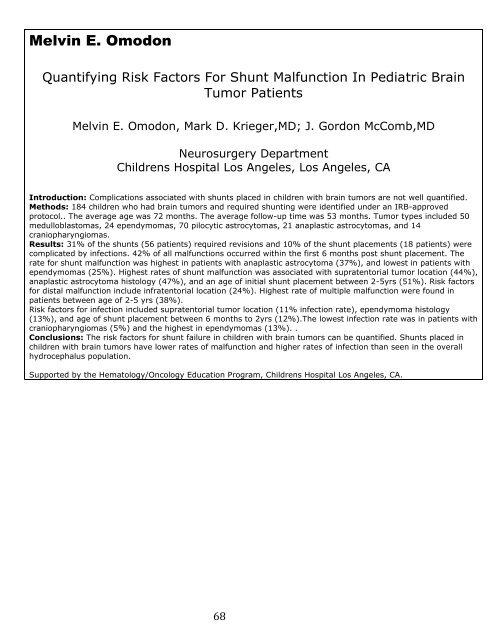student research day - Case Western Reserve University School of ...
student research day - Case Western Reserve University School of ...
student research day - Case Western Reserve University School of ...
You also want an ePaper? Increase the reach of your titles
YUMPU automatically turns print PDFs into web optimized ePapers that Google loves.
Melvin E. Omodon<br />
Quantifying Risk Factors For Shunt Malfunction In Pediatric Brain<br />
Tumor Patients<br />
Melvin E. Omodon, Mark D. Krieger,MD; J. Gordon McComb,MD<br />
Neurosurgery Department<br />
Childrens Hospital Los Angeles, Los Angeles, CA<br />
Introduction: Complications associated with shunts placed in children with brain tumors are not well quantified.<br />
Methods: 184 children who had brain tumors and required shunting were identified under an IRB-approved<br />
protocol.. The average age was 72 months. The average follow-up time was 53 months. Tumor types included 50<br />
medulloblastomas, 24 ependymomas, 70 pilocytic astrocytomas, 21 anaplastic astrocytomas, and 14<br />
craniopharyngiomas.<br />
Results: 31% <strong>of</strong> the shunts (56 patients) required revisions and 10% <strong>of</strong> the shunt placements (18 patients) were<br />
complicated by infections. 42% <strong>of</strong> all malfunctions occurred within the first 6 months post shunt placement. The<br />
rate for shunt malfunction was highest in patients with anaplastic astrocytoma (37%), and lowest in patients with<br />
ependymomas (25%). Highest rates <strong>of</strong> shunt malfunction was associated with supratentorial tumor location (44%),<br />
anaplastic astrocytoma histology (47%), and an age <strong>of</strong> initial shunt placement between 2-5yrs (51%). Risk factors<br />
for distal malfunction include infratentorial location (24%). Highest rate <strong>of</strong> multiple malfunction were found in<br />
patients between age <strong>of</strong> 2-5 yrs (38%).<br />
Risk factors for infection included supratentorial tumor location (11% infection rate), ependymoma histology<br />
(13%), and age <strong>of</strong> shunt placement between 6 months to 2yrs (12%).The lowest infection rate was in patients with<br />
craniopharyngiomas (5%) and the highest in ependymomas (13%). .<br />
Conclusions: The risk factors for shunt failure in children with brain tumors can be quantified. Shunts placed in<br />
children with brain tumors have lower rates <strong>of</strong> malfunction and higher rates <strong>of</strong> infection than seen in the overall<br />
hydrocephalus population.<br />
Supported by the Hematology/Oncology Education Program, Childrens Hospital Los Angeles, CA.<br />
68
















